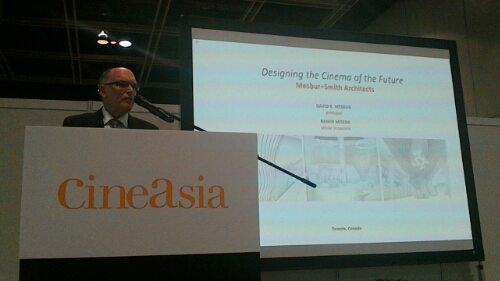
In an effort to provide updates on the CineAsia 2014 conference and trade show presently taking place in Hong Kong SAR, this post was written live, and in the present tense, during one of the conference’s presentations. Comments attributed to speaker(s) are paraphrased unless denoted specifically by quotation marks.
Mike Cummings, Principal, TK Architects
Mike opens by saying thanks CineAsia for including architecture in CineAsia university. “How do we continue to raise the level of cinema going experience?” he asks. “By using set design principles. There is a comfort sitting in the home,” so there is a challenge to get people to leave their couch. “As Jim Cameron said he doesn’t care if people watch his films third or fourt time on a smartphone, but first time should be in the theatre,” Mike observes.
Set design – what designers can do to enhance the experince. Make the lobby a key component of the experience. Make the lobby part of the show.
Style and atmosphere is one aspect – realistic, minimalist, traditionalist, luxurious, classic or contemporary.
Tone is another, colour, shape, rythm of visual elements.
Theme – favourite one for architects. Use central metaphore, such as ‘digital glamour’ and another is ‘luxury inside’ – probe deeper to find true beauty.
Visual Cues – [this presentation should really be seen with the great pictures Mike is using to illustrate each point.]
Seating groupings (better yet, ‘activity groupings’) – Think of different places and how people congregate.
Interactivity is the last principle – a whole group of consumers will not be happy with passively watching a film for two hours. So how to cater to them.
“Bringing it all together – with also music, sounds, props you can create a whole new kind of movie experience. Thank you.”
David Mesbur, Design Princippal, Mesbur+Smith Architects
Ramin Moeini, Senior Associate, Mesbur+Smith Architects (doesn’t speak, just clicks the slides)
“For those unfamilair with our work, we are world renowned boutique operation that does diverse work from multiplexes to restorations. World class expertise in design. State of the art creative solutions. [pictures are more telling than the words David speaks.] We have seen tremendous changes in the last decade and changed accordingly, so we can offer our clients the best and most up-to-date solutions.”
“The exciting news is that Asia is seeing the strongest growth, based on strong film base. From single purpose cinemas to mixed entertainment centres. 90% of M+S’s work is cinema-related.”
He then shows example of 19 screen complex accomodating over 3,000 people in 7,000 sq meters due to open in 2016, includes bowling, billiards, 6-screen VIP zone on two levels and 536 seat Imax theatre. This in a Middle East market. “Common thread is that we have shifted our concept design to vastly increase the offerings compared.”
Another trend of mixed seat auditoriums with VIP seats in the rear. Previous example has that, with premium seating above the cross aisle where patrons enter. Imax also has VIP private boxes. Another is the ALL VIP IMAX in Russia at $100 per ticket. [was that before or after the Rubel crashed in value?] “Exclusive luxury cinema experience.”
Final trend is new digital projection expanded offerings – live events, etc. Can customise auditoriums for special requirements, dinner theatres, children’s seating, performing art theatres, class room use cinemas. Without need for projection booth, there is more flexibility in designing the complex. Restaurants and theatres can be co-located. Cinema design is in a period of dramatic change.
“To design the cinema of the future we have to think strategically.”
And with that the 3×15 minute sprint sessions ended. Productive format, so kudos to ICTA.
